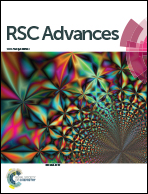Hybrid silver nanoparticle/nanocluster-decorated polypyrrole for high-performance supercapacitors
Abstract
In the present work, a composite electrode consisting of hybrid silver nanoparticle/nanocluster-decorated polypyrrole (PPy) demonstrates an enhanced specific capacitance of 414 F g−1 than that of the pure PPy electrode (273 F g−1). The enhanced specific capacitance was mainly attributed to the unique architecture and hybrid nanostructures of Ag. The Ag nanoparticles enhanced the electron hopping system of the PPy, effectively increasing the capacitance properties of the PPy. On the other hand, the Ag nanoclusters acted as spacers to prevent the restacking of PPy films, further extending the active sites for redox reactions, leading to improved specific capacitance. A symmetric supercapacitor device built from the hybrid Ag@PPy nanocomposite yielded a specific capacitance of 161 F g−1 per mass of one electrode and exhibited remarkable cycling stability of 98.9% capacitance retention over 1000 charge/discharge cycles. These excellent electrochemical performances show the promise of the hybrid Ag@PPy nanocomposite in energy storage devices.



 Please wait while we load your content...
Please wait while we load your content...